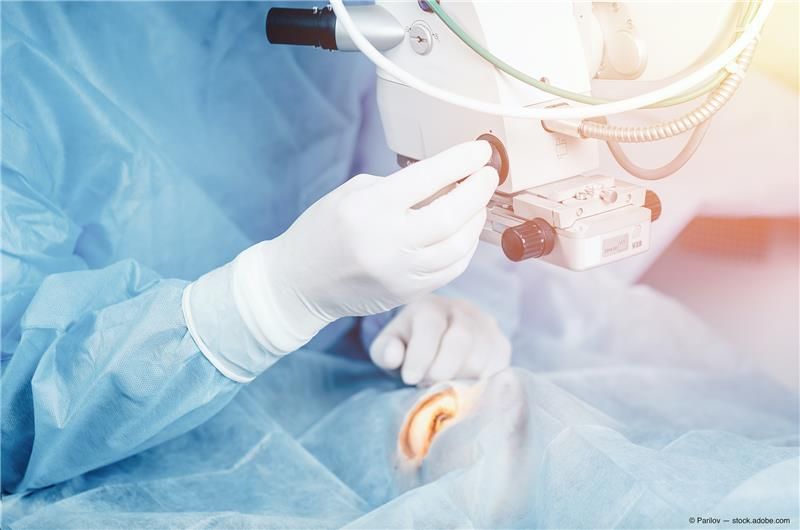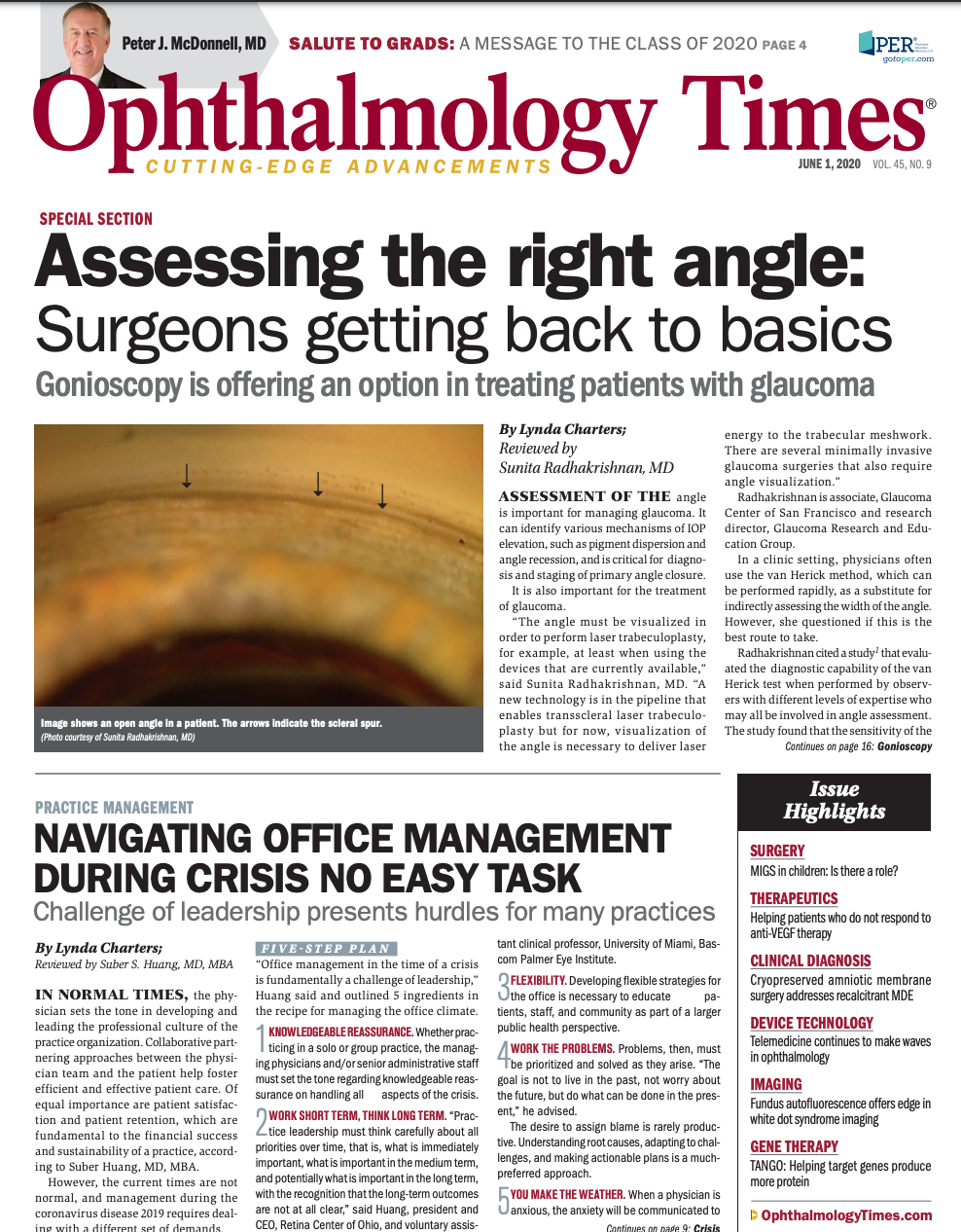Publication
Article
Digital Edition
Is the time right for crosslinking?
Author(s):

For practices yet to jump into CXL, changes may warrant a closer look.
Special to Ophthalmology Times®
Corneal collagen crosslinking (CXL) for the treatment of keratoconus is a procedure that has stood the test of time.
Available in Europe for the past 15 years and nearly 4 years in the United States, it is by now well established as a great option for patients with progressive keratoconus.1
Unlike any other treatment for keratoconus, CXL is effective at slowing or halting disease progression,2-4 while improving vision- and health-related quality of life.5,6
Many cornea practices were early adopters of CXL technology, but the time may be right for comprehensive ophthalmologists to explore this technology, as well. CXL is certainly well within the skill set of any anterior segment surgeon.
As our practices emerge from the global health and financial crisis caused by the COVID-19 pandemic, CXL is a procedure that can begin sooner than some others, given its minimally invasive nature and younger candidate pool.
Recent data suggest a higher level of patient need for treatment than previously thought.7 And we now have a much clearer reimbursement path and lower barriers to entry than existed in the early years of CXL availability in the United States.
Higher incidence of prevalence of keratoconus
The prevalence of keratoconus (Figure 1) has generally been accepted to be approximately 1 in 2,000 or 1 in 3,000, making it a relatively rare condition.8
More recently, an analysis of 4.4 million patients covered by the Netherlands’ largest health insurer found an annual incidence and estimated prevalence of keratoconus that is 5- to 10-fold higher than historical estimates (Figure 2).7
The researchers found that keratoconus affected about 1 in 7,500 people in the 10- to 40-year-old age group each year, for an overall prevalence within the population of 1 in 375 people, or 265 per 100,000.7
A number of factors have likely contributed to this jump in prevalence. First, computer-based corneal imaging technologies have improved dramatically, leading to earlier and more accurate diagnoses.9
We know that keratoconus has a genetic predisposition, which is often compounded by iatrogenic factors such as eye rubbing, and that it is more common in patients with longer axial length and more highly myopic eyes.10
So, with rising rates of myopia/high myopia and obesity, which have been associated with sleep apnea and eye rubbing, it is not surprising that we are seeing more cases of keratoconus.
Given the higher estimates of keratoconus prevalence in the population, we likely do not have enough cornea specialists or current CXL providers to treat everyone who would benefit right now. There is a need for CXL; providing the procedure is a significant service to the community.
Reimbursement path
Early on, as with many new ophthalmic procedures, there were problems with reimbursement for CXL that made many practices hesitant to offer it.
Today, the majority of commercial health plans in the United States-representing more than 95% of commercially covered lives-recognize CXL with the FDA-approved drugs and device as a covered service, so the barriers to launching CXL within a practice have been significantly lowered.
The procedure can be performed in the office or in a surgery center environment. There is only 1 CXL system approved in the United States: The KXL system, used along with Photrexa Viscous (riboflavin 5’-phosphate in 20% dextran ophthalmic solution) and Photrexa (riboflavin 5’-phosphate ophthalmic solution) (all from Avedro, now part of the Glaukos Corneal Health Division).
The return on investment is rapid, with most practices able to recoup their investment in a year or less. The company has recently expanded both its reimbursement support and financing options to ease the acquisition process for practices.
The ophthalmic solutions now have a J code for reimbursement, so there is not as much concern about receiving adequate compensation for needed supplies.
The procedure typically takes a total of 1 to 2 hours, so practices need to allocate appropriate clinical staff time and space in the office for a procedure of that duration.
CXL is indicated and reimbursed for progressive keratoconus, so it is important to establish procedures for documenting progression. This process does not need to be daunting.
Although the ideal would be to have serial topographies demonstrating progression, we also know that the chance of progression in patients younger than 25 years of age is very high, and historical topography may not be available.
In these younger patients, a significant increase in the manifest refraction (myopia or cylinder) over the course of 1 to 2 years with a keratoconus topography map may be sufficient evidence of progression. In the absence of patient records, prior spectacles may be useful in evaluating changes in refraction.
Although keratoconus progression slows or stops, on average, by age 40, there are certainly individuals who progress well beyond the typical range, into their 60s.11
In my experience, these patients are most likely to be significant eye rubbers, particularly with floppy eyelid syndrome12 and sleep apnea,13 so I follow such patients carefully.
With a clear reimbursement pathway and fewer hurdles to beginning CXL, ophthalmologists can now viably perform the procedure, meeting a significant patient need.
This, of course, also requires a redoubling of efforts to educate local physicians and optometrists about keratoconus and CXL. I believe we are moving rapidly toward a new paradigm in which any young patient who develops myopia and astigmatism should undergo corneal topography.
We need low-cost, accessible topographers so that more optometrists can routinely perform this diagnostic test as part of their exam. Making the diagnosis and undergoing CXL even a year or 2 earlier can mean the difference between a lifetime of quality vision with glasses and the need to wear specialty rigid gas permeable or scleral contact lenses.
Patients who are able to successfully remain in contact lenses have a reduced risk of requiring a corneal transplant in the future.14 We owe it to our patients to give them the opportunity to achieve the best possible outcomes.
Eric D. Donnenfeld, MD
E: ericdonnenfeld@gmail.com
Dr. Donnefeld is in private practice with Ophthalmic Consultants of Long Island in Garden City, New York. He is a trustee of Dartmouth Medical School and a clinical professor of ophthalmology at New York University Medical Center. He is a consultant for many ophthalmic companies, including Glaukos.
References:
Gomes JAP, Tan D, Rapuano CJ, et al; Group of Panelists for the Global Delphi Panel of Keratoconus and Ectatic Diseases. Global consensus on keratoconus and ectactic diseases. Cornea. 2015;34(4):359-369.
Hersh PS, Stulting RD, Muller D, et al; United States Crosslinking Study Group. United States Multicenter Clinical Trial of Corneal Collagen Crosslinking for Keratoconus Treatment. Ophthalmology. 2017;124(9):1259-1270.
Shetty R, Pahuja NK, Nuijts RM, et al. Current protocols of corneal collagen cross-linking: visual, refractive, and tomographic outcomes. Am J Ophthalmol. 2015;160(2)243-249.
Raiskup F, Theuring A, Pillunat LE, Spoerl E. Corneal collagen crosslinking with riboflavin and ultraviolet-A light in progressive keratoconus: ten-year results. J Cataract Refract Surg. 2015;41(1):41-46.
Cingu AK, Bez Y, Cinar Y, et al. Impact of collagen cross-linking on psychological distress and vision and health-related quality of life in patients with keratoconus. Eye Contact Lens. 2015;41(6):349-353.
Brooks NO, Greenstein S, Fry K, Hersh PS. Patient subjective visual function after corneal collagen crosslinking for keratoconus and corneal ectasia. J Cataract Refract Surg. 2012;38(4):615-619.
Godefrooij DA, de Wit GA, Uiterwaal CS, et al. Age-specific incidence and prevalence of keratoconus: a nationwide registration study. Am J Ophthalmol. 2017;175:169-172.
Kennedy RH, Bourne WM, Dyer JA. A 48-year clinical and epidemiologic study of keratoconus. Am J Ophthalmol. 1986;101(3):267-273.
Masiwa LE, Moodley V. A review of corneal imaging methods for the early diagnosis of pre-clinical keratoconus. J Optom. pii: S1888-4296(19)30104-9. doi: 10.1016/j.optom.2019.11.001
Mas Tur V, MacGregor C, Jayaswal R, et al. A review of keratoconus: diagnosis, pathophysiology, and genetics. Surv Ophthalmol. 2017;62(6):770-783.
Gokul A, Patel DV, Watters GA, McGhee CNJ. The natural history of corneal topographic progression of keratoconus after age 30â years in non-contact lens wearers. Br J Ophthalmol. 2017;101(6):839-844.
Donnenfeld ED, Perry HD, Gibralter RP, et al. Keratoconus associated with floppy eyelid syndrome. Ophthalmology. 1991;98(11):1674-1678.
Naderan M, Rezagholizadeh F, Zolfaghari M, et al. Association between the prevalence of obstructive sleep apnoea and the severity of keratoconus. Br J Ophthalmol. 2015;99(12):1675-1679.
Dana MR, Putz JL, Viana MA, et al. Contact lens failure in keratoconus management. Ophthalmology. 1992;99(8):1187-1192.
Newsletter
Don’t miss out—get Ophthalmology Times updates on the latest clinical advancements and expert interviews, straight to your inbox.





